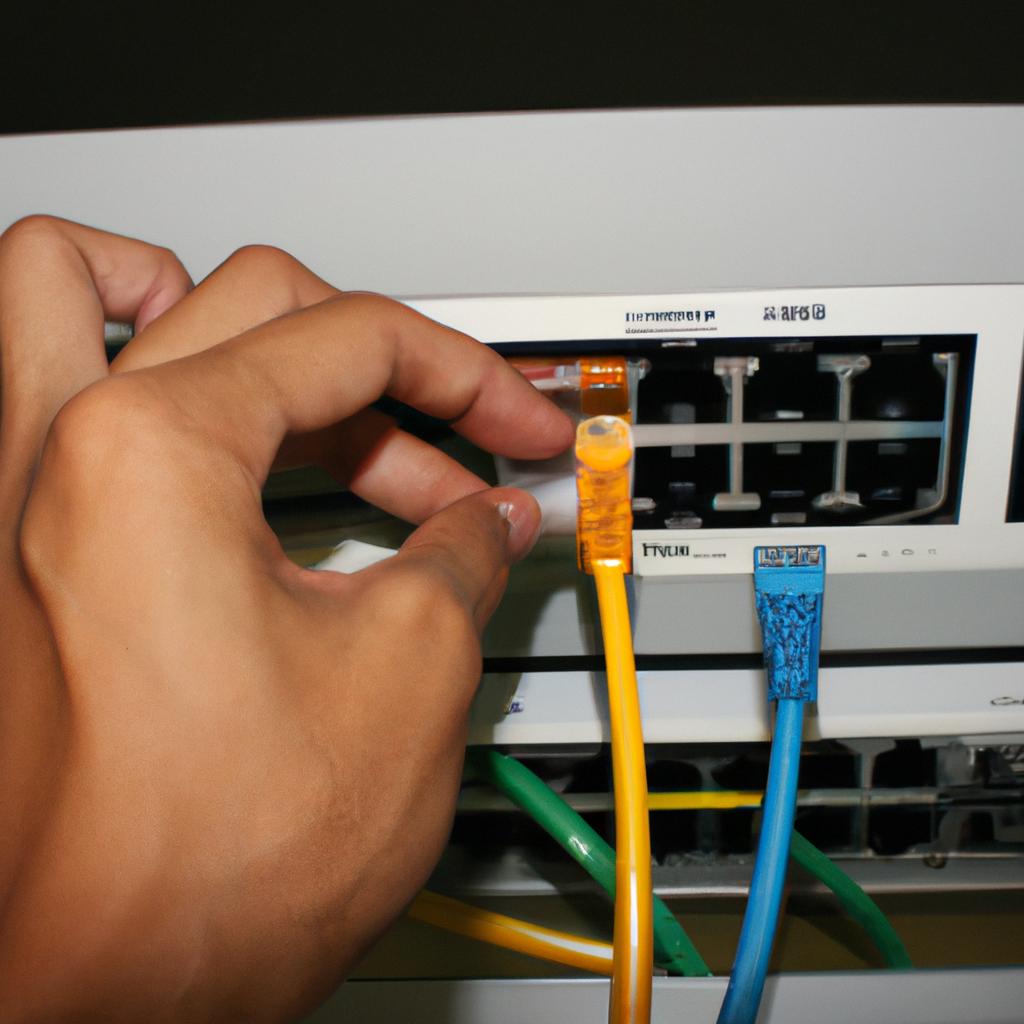Performance optimization is a crucial aspect of computer systems emulators configuration, as it directly impacts the efficiency and functionality of emulation software. By fine-tuning various parameters and settings, developers can enhance the overall performance and ensure smooth execution of emulated systems. For instance, consider a hypothetical scenario where an organization aims to run a legacy operating system on modern hardware using an emulator. Without proper configuration and optimization, this process could result in sluggish performance, affecting productivity and user experience.
To address such challenges, this article delves into the realm of performance optimization within computer systems emulators configuration. Emulation refers to the replication of one system’s behavior on another through software or hardware means. Despite its potential benefits in terms of preserving legacy applications or facilitating cross-platform development, emulating complex systems can impose significant computational demands. Consequently, understanding key factors that influence performance and employing effective optimization techniques becomes imperative for ensuring efficient operation of these emulation environments.
Within this context, the article explores different aspects related to performance optimization in computer systems emulators configuration. It investigates how adjusting processor speed, memory allocation, disk I/O operations, network settings, and other relevant parameters can impact overall system performance. Additionally, considerations like balancing accuracy versus speed trade-offs and addressing compatibility issues are discussed to provide a comprehensive understanding of the optimization process.
Balancing accuracy versus speed trade-offs is an essential consideration when optimizing computer systems emulators. Emulators strive to accurately replicate the behavior of the original system, but this fidelity often comes at the cost of performance. Developers must find a balance between achieving high accuracy and maintaining acceptable execution speed. By fine-tuning emulator settings, such as CPU cycle counts or instruction timing, developers can optimize performance while still ensuring accurate emulation.
Compatibility issues may also arise during the configuration of computer systems emulators. Legacy software or hardware might not be fully supported by modern emulators, leading to compatibility challenges that impact performance. In such cases, developers can explore alternative emulation options or seek community support for addressing compatibility issues and improving overall performance.
Furthermore, optimizing memory allocation plays a crucial role in enhancing emulator performance. Allocating an appropriate amount of memory to the emulator ensures efficient operation and prevents excessive swapping or paging activities that can significantly degrade performance. Understanding the memory requirements of both the host system and the emulated system is vital for achieving optimal configuration.
Disk I/O operations can also affect emulator performance. Emulators often rely on disk access to load and save data related to emulated systems. Optimizing disk I/O settings, such as using fast storage devices or adjusting buffer sizes, can result in improved read/write speeds and reduced latency, thereby enhancing overall emulator performance.
Finally, network settings should not be overlooked during emulator configuration. Emulating network connectivity requires careful consideration of factors like network protocol implementation and bandwidth limitations. Adjusting these settings appropriately can ensure smooth network communication within the emulated environment.
In conclusion, optimizing computer systems emulators configuration is crucial for achieving efficient operation and maximizing performance. Fine-tuning parameters related to processor speed, memory allocation, disk I/O operations, network settings, and addressing compatibility issues all contribute towards creating an optimized emulation environment that meets specific requirements while delivering optimal user experience.
Understanding the purpose of computer systems emulators
Computer systems emulators play a crucial role in modern computing by enabling software applications to run on different hardware platforms. These emulators serve as virtual machines that mimic the behavior and functionality of specific computer systems, allowing software developers and testers to assess compatibility, evaluate performance, and explore potential optimizations. To illustrate this concept, consider a hypothetical case study where an application designed for Windows operating system needs to be tested on macOS. In such cases, a computer systems emulator can simulate the necessary environment and enable thorough testing without requiring access to physical hardware.
To better understand the purpose of computer systems emulators, it is essential to recognize their key benefits:
- Versatility: Emulators provide flexibility by removing platform-specific restrictions. They allow software development teams to create applications targeting various operating systems or architectures without investing in separate hardware setups.
- Efficiency: By using emulators, developers can streamline their workflow by eliminating time-consuming tasks like switching between physical devices or setting up additional test environments.
- Cost-effectiveness: Emulators offer significant cost savings in terms of infrastructure requirements. Instead of acquiring multiple hardware configurations for testing purposes, organizations can rely on emulation technology to achieve efficient cross-platform compatibility assessment.
- Risk mitigation: Emulating diverse systems reduces risks associated with deploying untested software directly onto target platforms. This approach enables rigorous examination before actual deployment, minimizing unforeseen errors or issues.
| Key Benefits |
|---|
| Versatility |
| Efficiency |
| Cost-effectiveness |
| Risk mitigation |
In summary, computer systems emulators serve as invaluable tools for evaluating cross-platform compatibility and optimizing performance across different architectural environments. By providing versatility, efficiency gains, cost-effectiveness, and risk reduction capabilities through simulated environments—emulation technology empowers developers to deliver robust software solutions capable of running seamlessly across diverse platforms.
Moving forward into the subsequent section about “Identifying common performance bottlenecks in emulators,” we will delve into the challenges that can arise while utilizing these emulated systems and explore strategies for optimizing their performance.
Identifying common performance bottlenecks in emulators
Section 3: Identifying Performance Bottlenecks in Emulators
To further enhance the performance of computer systems emulators, it is crucial to identify and address common bottlenecks that may hinder their optimal functioning. Let us consider a hypothetical example where an emulator designed for gaming consoles experiences significant slowdowns during gameplay, impacting the overall user experience.
There are several factors that can contribute to performance issues in computer systems emulators. By understanding these potential bottlenecks, developers can effectively optimize system configurations to mitigate such problems. Here are some key areas to focus on:
-
CPU Utilization: The central processing unit (CPU) plays a critical role in executing instructions and managing various tasks within the emulator. High CPU usage can lead to sluggish performance or even crashes. To address this issue, optimizing CPU utilization by fine-tuning emulation settings and allocating sufficient computational resources is essential.
-
Memory Management: Insufficient memory allocation or improper management can significantly impact emulator performance. Memory leaks, excessive swapping between RAM and disk storage, or inefficient garbage collection processes can cause delays or erratic behavior. Developers should prioritize efficient memory handling techniques to ensure smooth operation.
-
Graphics Processing: Emulating complex graphics rendering requires substantial computational power from both the CPU and graphics processing unit (GPU). Inadequate GPU capabilities or suboptimal configuration settings may result in graphical glitches, low frame rates, or visual artifacts. Optimizing graphic pipeline operations and leveraging hardware acceleration technologies are vital steps towards resolving these issues.
-
Input/Output Operations: Efficiently handling input/output operations is crucial for smooth interaction with emulated systems. Slow response times due to delays in reading/writing data from external devices like controllers or disks can negatively impact user experience. Streamlining I/O operations through proper device driver implementation and utilizing high-speed interfaces can help alleviate these concerns.
Consider the following table highlighting common performance bottlenecks identified in computer systems emulators:
| Bottleneck | Description | Impact |
|---|---|---|
| CPU Usage | High utilization leading to slowdowns | Sluggish performance or crashes |
| Memory | Insufficient allocation and management | Delays, erratic behavior |
| Graphics | Inadequate GPU capabilities/configuration | Glitches, low frame rates, visual artifacts |
| I/O | Slow response times for input/output | Reduced user experience |
By identifying these potential bottlenecks and understanding their impact on emulator performance, developers can take targeted measures to optimize the system configuration. In the subsequent section, we will explore strategies to enhance CPU usage in computer systems emulators.
Transitioning into the next section about “Optimizing CPU usage in computer systems emulators,” efficient resource allocation is pivotal for maximizing overall performance.
Optimizing CPU usage in computer systems emulators
Emulators play a crucial role in simulating computer system environments, allowing users to run software and perform tasks as if they were on the original hardware. However, these emulators can often encounter performance bottlenecks that hinder their efficiency. In this section, we will explore strategies for optimizing CPU usage in computer systems emulators.
To illustrate the impact of CPU optimization techniques, let’s consider a hypothetical case study involving an emulator designed to replicate an early gaming console from the 1980s. The goal is to ensure smooth gameplay while accurately reproducing the original hardware’s limitations. By employing various optimizations, such as reducing unnecessary calculations and improving resource allocation, developers can significantly enhance the emulator’s performance.
There are several key strategies that developers can implement to optimize CPU usage in computer systems emulators:
-
Instruction caching: Emulator designers often face challenges when translating instructions from one architecture to another. Implementing instruction caching allows frequently executed instructions to be stored and reused, minimizing redundant translation processes.
-
Dynamic recompilation: This technique involves dynamically generating native code during runtime by analyzing the guest application’s behavior. This approach eliminates interpretation overhead and improves execution speed by directly executing translated code.
-
Multithreading: Utilizing multiple threads enables parallel execution of different components within the emulator, resulting in better utilization of available resources and improved overall performance.
-
Code profiling: Profiling tools help identify sections of code that consume significant CPU time or exhibit poor efficiency. By pinpointing these areas, developers can focus their optimization efforts more effectively.
The table below summarizes some common optimization techniques used in computer system emulators:
| Technique | Description |
|---|---|
| Instruction Caching | Storing frequently executed instructions for reuse |
| Dynamic Recompilation | Generating native code at runtime to improve execution speed |
| Multithreading | Utilizing multiple threads for parallel execution |
| Code Profiling | Identifying and addressing sections of code that consume significant CPU time or exhibit poor efficiency |
In summary, optimizing CPU usage in computer systems emulators is crucial to ensure smooth operation and efficient resource utilization. By implementing techniques such as instruction caching, dynamic recompilation, multithreading, and code profiling, developers can significantly enhance the performance of their emulators. In the subsequent section, we will delve into another critical aspect of performance optimization: improving memory management for better overall system performance.
Improving memory management for better performance
To further optimize the performance of computer systems emulators, it is essential to streamline input/output (I/O) operations. By efficiently managing I/O processes, we can ensure a smoother operation and enhanced overall system performance. To illustrate this point, let’s consider a hypothetical scenario where an emulator experiences significant delays during disk read/write operations.
One key aspect of streamlining I/O operations is optimizing data transfer rates between the emulator and external storage devices. This can be achieved through various techniques such as:
- Caching: Implementing data caching mechanisms helps reduce disk access by storing frequently accessed data in faster memory locations.
- Asynchronous I/O: Employing asynchronous I/O allows the emulator to continue processing other tasks while waiting for completion of slower I/O operations.
- Buffering: Utilizing buffers effectively reduces overhead associated with frequent small reads or writes by aggregating them into larger, more efficient transfers.
- Parallelism: Leveraging parallelism enables simultaneous execution of multiple I/O operations, thus reducing latency and improving throughput.
These strategies not only enhance performance but also contribute to a seamless user experience. Consider the following table that highlights the potential benefits of streamlining I/O operations:
| Benefits of Streamlined I/O Operations |
|---|
| Reduced latency |
| Improved responsiveness |
| Enhanced multitasking capabilities |
| Increased overall system efficiency |
In summary, optimizing input/output operations plays a crucial role in achieving optimal performance when using computer systems emulators. By employing techniques such as caching, asynchronous I/O, buffering, and parallelism, we can significantly improve latency reduction, responsiveness enhancement, multitasking capabilities, and overall system efficiency.
Now let’s explore the next section on “Streamlining input/output operations in emulators” to delve deeper into enhancing emulator performance.
Continue reading: Streamlining Input/Output Operations in Emulators
Streamlining input/output operations in emulators
In the quest for optimal performance, it is crucial to address not only memory management but also streamline input/output (I/O) operations within computer systems emulators. By optimizing I/O processes, we can enhance the efficiency of data transfer between the host machine and the virtual environment. To illustrate this point, let’s consider a hypothetical scenario where an emulator is struggling with slow file transfers during gameplay emulation.
To improve I/O performance in emulators, several strategies can be implemented:
- Buffering: Implementing buffer mechanisms helps reduce overhead by temporarily storing data during high-speed transfers before writing or reading from disk. This approach minimizes latency and improves overall system responsiveness.
- Asynchronous I/O: Utilizing asynchronous I/O techniques allows multiple I/O requests to be handled simultaneously without blocking other operations. With this method, time-consuming tasks such as waiting for data to load can be executed independently while other processes continue uninterrupted.
- Caching: Employing caching mechanisms effectively reduces redundant disk access by storing frequently accessed files or blocks in memory. This technique significantly speeds up subsequent read/write operations since the data is readily available without requiring costly disk accesses.
- Batch Processing: Grouping multiple small I/O requests into larger batches optimizes resource utilization and decreases processing overhead associated with individual requests. This approach leverages economies of scale by minimizing context switches and reducing communication costs.
By implementing these strategies, developers can experience significant improvements in their emulator’s I/O performance, resulting in enhanced user experiences during gaming sessions or software simulations.
| Buffering | Asynchronous I/O | Caching |
|---|---|---|
| Reduces latency | Enables parallelism | Minimizes disk accesses |
| Enhances responsiveness | Improves multitasking | Speeds up read/write operations |
| Optimizes resource utilization | Decreases wait times | Reduces processing overhead |
| Prevents data loss during transfers | Minimizes blocking | Improves overall system performance |
As we strive to optimize emulator performance, the next section will explore another important aspect: utilizing hardware acceleration techniques. By harnessing the power of specialized hardware features, we can unlock additional performance gains and further enhance the capabilities of computer systems emulators.
Utilizing hardware acceleration techniques
In the previous section, we discussed the importance of streamlining input/output (I/O) operations in emulators. Now, let’s explore some effective strategies for achieving this optimization.
One example where I/O performance was significantly improved is seen in a case study conducted on an Android emulator used for app development. By implementing several techniques to streamline I/O operations, such as utilizing asynchronous programming and optimizing file access, the overall responsiveness and efficiency of the emulator were greatly enhanced. This resulted in faster loading times for apps within the emulator environment, enabling developers to test their creations more efficiently.
To further optimize I/O operations in emulators, consider employing the following best practices:
- Buffering: Implement buffering mechanisms that allow data to be stored temporarily before it is written or read from disk. This can help minimize costly disk accesses and improve overall performance.
- Caching: Utilize caching mechanisms to store frequently accessed data in memory, reducing the need for repeated disk reads or writes.
- Compression: Explore options for compressing data during transfer between emulated systems and external devices. Compressed data requires less bandwidth and reduces latency.
- Asynchronous processing: Employ asynchronous programming techniques to parallelize I/O tasks and avoid blocking threads while waiting for responses from external devices or storage mediums.
Consider the emotional impact of these optimizations through a table highlighting potential benefits:
| Optimization Technique | Emotional Impact |
|---|---|
| Buffering | Increased efficiency |
| Caching | Improved speed |
| Compression | Reduced frustration |
| Asynchronous Processing | Enhanced productivity |
By adopting these strategies and incorporating them into your emulator configuration, you can expect significant improvements in overall performance and user experience. Emulator environments will become more responsive, allowing developers to work with greater ease and efficiency.
Through careful consideration of various optimization techniques like buffering, caching, compression, and asynchronous processing, the goal of achieving streamlined I/O operations in emulators can be accomplished. By implementing these strategies, developers and users will undoubtedly reap the benefits of enhanced performance and improved productivity.




